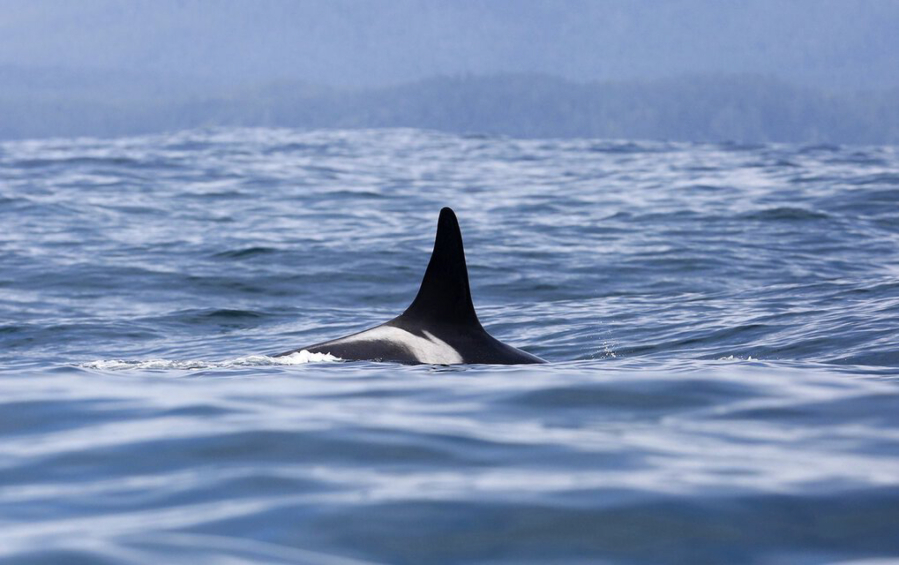She is still out there: cruising miles uncounted, leading her family to fish.
L25 is the world’s oldest known living wild orca, the uncontested reigning matriarch of the southern resident orcas that frequent Puget Sound. She ascended to that post after the death of J2, in 2017 at an estimated age of 105.
No one knows exactly how old L25 is, said Michael Weiss, research director of the nonprofit Center for Whale Research.
But “our best estimate is she is approaching 100 years old right now,” Weiss said. The original estimate for her year of birth was 1928 when the center’s census of the J, K and L pods began in 1976, Weiss said. His personal guess is that she might be anywhere from her mid-80s to her mid-90s.
But who’s counting — she is going strong whatever her age. “She looks fine, she looks good; these old whales don’t outwardly age very much,” Weiss said. “They don’t get wrinkles; they don’t get decrepit.
“She is very much large and in charge.”
As the oldest orca she takes a leadership role — particularly when times are tough. “What these older females contribute is when we look at who is at the front of the group, who is leading it around, it is these old females,” Weiss said. “Particularly when prey is limited, you are more likely to find a female at the front of the group in a year with really bad salmon.”
L25 has seen it all, Weiss said, the good years, the bad years, and she carries a vast ecological knowledge of where to find fish.
She is a living environmental archive, a witness to vast environmental change. L25 was born before any of the dams were built on the Columbia or Snake rivers, or the Sacramento or Green River. She was born when the population of the entire state was about 1.5 million people — instead of nearly 8 million today.
She outlived the capture era, from 1965 to 1976, when orcas were netted for aquariums — and even outlived the last surviving southern resident in captivity, Tokitae, who died in August even as efforts were underway to bring her home after more than 50 years in captivity at the Miami Seaquarium.
She has lived through salmon famines, and because she was born so long ago, a time of salmon abundance. It shows in her body.
L25 is bigger than the other orcas in the southern resident pods because she was able to eat well when young. The salmon declines the younger whales today have grown up with have taken a toll on their bodies. They are measurably shorter, by as much as a half a meter, researchers have found.
With her hunting prowess honed lifelong, perhaps it is no coincidence that of the family groups in the southern residents, L pod is the most successful, with the most members, including two babies that survived the past year, Weiss noted.
“She is a spectacular whale, just a gorgeous animal,” said Deborah Giles, science and research director for the research nonprofit Wild Orca.
“She has led an amazing life, and seen so much.”
The loss of L25, whenever it comes, will be the end of an era: the next oldest orca in line is L22, who is more than 40 years younger if L25 is 95.
The southern residents face at least three challenges to their survival: vessel noise, which makes it harder for them to hunt; lack of consistently available, adequate food, especially Chinook salmon; and pollution in their food. Those toxics, including polychlorinated biphenyls or PCBs, are particularly damaging when orcas are hungry, and burn their fat, releasing toxics into their blood, Weiss said.
The southern residents’ reproductive capacity is hurt by all the threats they face. While their population has ticked up to 75, their reproductive rate is markedly less than the northern resident orcas. They are also fish-eating orcas but live in cleaner, quieter waters with access to more fish in their waters including southeast Alaska and northern Vancouver Island.
If the southern residents’ birthrate matched the northern residents, they would be producing six live babies a year, Weiss said. “Instead, we are getting two.”
“And that is in a good year.”
He noted that during the center’s census year from July 1, 2022, to July 1, 2023, no southern residents died — a first in three decades of the census. But since then a K pod whale has gone missing.
“This census year is a small bit of optimism in a larger story of continued decline,” Weiss said. “We managed to go a year, but we may have lost a whale shortly after. We had two calves. But there should be more.”
Through it all, L25 keeps going. Each year, researchers wonder if they will see her yet again. In August, Giles while doing orca research off the west side of San Juan Island, was thrilled when she caught sight of L25 and her family group.
“It was such a joy to see her.”



